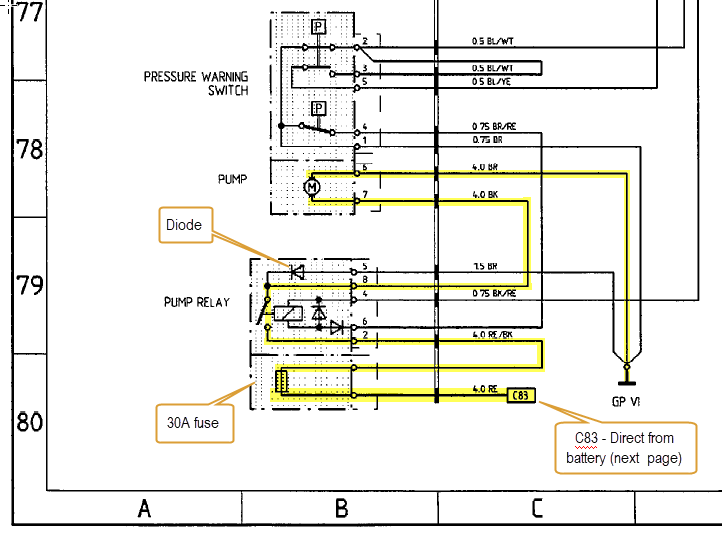

The 5-pin connector is on the pressure switch, but none of those wires are
fused by the 30A fuse. However that pressure switch does control the relay,
which connects battery voltage through the 30A fuse to the pump motor. So if the
fuse blows with the pump disconnected, and doesn't blow when the pressure-switch
is disconnected (and the relay does not actuate), then there is a short to
ground on the large (4.0mm) black wire from relay to motor. Pull the fuse,
disconnect the motor, and check resistance to ground with a multimeter (ohms
scale-- should be open-circuit).
The 30A fuse that is blowing is the power for the motor, which doesn't go
through the switch. The fuse is blowing when the relay closes, and the switch is
controlling the relay. But it is not the cause of the short-circuit.
Here is the wiring diagram (page 9 of the '93 wiring here, but they are all the
same): The 12V high-current path to the motor is highlighted. The motor power
comes direct from the battery on a 4.0mm red wire (the C83 reference to the next
page). It goes through the 30A fuse to the relay. When the relay contact is open
(as shown here) everything is fine. But when the relay clicks and closes, the
fuse blows. Follow the circuit-- it goes to the motor, and then through the
motor to ground. It doesn't go to the switch at all-- just the fuse, relay and
motor. If the motor is jammed then the fuse will blow, but not instantly.
There is one more possible path to ground, and that is the diode inside the
relay. That is there to protect the relay contacts. When the relay opens, the
motor continues to spin for a moment and will generate current in the same
direction. That current will flow through the diode from ground instead of
arcing across the relay contacts as they open. But if that diode is shorted,
then it will blow the fuse just like a shorted wire.
So if the wiring is OK, then the next step is to replacing the relay. Or take it
apart and replace the diode, but if you listen carefully you can hear the
chanting on the list: "relay, relay, relay ...". Just replace it, relays do go
bad.
You can also try checking the diode with a meter, but that is sometimes
difficult because of the low voltage that some meters use. If the meter has a
diode-checking "beeper" function then you can try that. The diode should show
0.7v drop in the direction of the arrow, and open-circuit in the reverse
direction.
The motor does run OK when jumpered direct to battery, correct?
Jim Corenman
